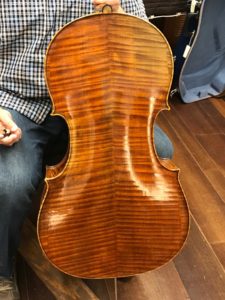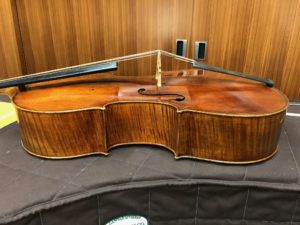On a recent trip to Washington, DC, I had the opportunity to spend some time with the 1701 ‘Servais’ Stradivari cello that is cared for at a Smithsonian museum. This was a monumental event for me, as I have admired this particular cello above all others for as long as I can remember. My experience with it did not disappoint. I offer you this rather long description of both my experience with the cello and background on how I approach trying instruments…
This is my attempt to describe playing the 1701 ‘Servais’ Stradivari cello. My purpose in writing this is to both cement the experience in my own mind and discuss how I evaluate an instrument unfamiliar to me. This entire exercise will likely only be of interest to a few friends, but I felt it worthwhile to share as it might spark an interesting dialogue on the subject.
First, a few caveats and qualifications. I count among my friends individuals who are far finer cellists, individuals who have significantly more experience playing antique instruments from the great masters, and individuals who have deeper knowledge of the great masters’ work. In a case or two, one person might fit all three categories! Also, I have studied and revered the ‘Servais’ for several decades – I am not an impartial judge. Finally, the amount of time I played the instrument wasn’t even a tiny fraction of the time that would be required to fully explore its capabilities. The great cellist Anner Bylsma called the ‘Servais’ cello “limitless”. I agree.
I’ve discussed the process of trying an instrument with musicians, makers, dealers, and friends from entirely different fields. Any number of “systems” exist; many of them developed in the past and handed down from teacher to pupil generation after generation. These systems are necessary in their own way because musicians often attempt to compare instruments separated by both time and space. Relying entirely on our memory can be a dangerous tactic when our impressions of an instrument are affected by countless variables, both external and internal. We also can’t escape the fact that the sound we hear as a player is not the sound heard by our audience. Even attempting to compare sound via recordings is fraught with challenges.
Once we’ve reconciled ourselves to all of the difficulties and challenges of comparing instruments, we still need to wrestle with the conclusion we’re trying to reach. Are we searching for the “best sounding” instrument? If so, are we defining “best” for ourselves or is there some kind of objective ideal? We must also concede that the instrument on which I create the “best” sound will invariably sound different when you play it. Some musicians are sharpeners – their technique seems to amplify the sometime subtle differences between instruments. Some musicians are levelers – their technique seems to equalize even sometimes large differences between instruments.
In light of all this, I admit I am primarily looking for a certain “feel” as the primary metric of quality when trying an instrument unfamiliar to me. I have played cellos with the desired “feel” that display radically different sound characteristics – reedy like an oboe, thunderous like an organ, soaring like a great tenor high in his range, dense and textured like a French horn. When an instrument has the feel I want and produces a beautiful, nuanced sound, I find it difficult to rank it as “better” or “worse” than other instruments possessing the desired feel but a very different sound – even for myself.
So what is this “feel”? One of the ways I can describe it is to think of the string as a pillow…and I’m Goldilocks. If the string feels too firm under the bow, creating the sound can feel too brittle and wiry. If the string feels too soft under the bow, creating the sound can feel shaky and rubbery. So am I just talking about the string, and isn’t what I’m describing just a function of what make/line of strings is on the instrument? No. For me, what I’m describing has very little to do with the make/line of strings on the instrument, given a reasonable expectation of quality and condition. The second part of the feel is what I think of as “horsepower”. I want the instrument to give me the impression that the smallest variation in input – left or right hand – will create a nearly instantaneous change in tone and volume. One of my favorite places on the cello to test this is shifting from C4 to E4 on the A-string, although I conduct the same test all over the cello given enough time. On the A-string, I start with a mezzo-piano C with a floating bow and wider/slower vibrato…then shift up to a forte E, moving the bow closer to the bridge and intensifying the vibrato. On many excellent cellos, this becomes the sonic equivalent to going 0-60mph in a Bugatti Chiron. It’s as if I’m being pushed along at dizzying speed by effortless power…once you feel it, it becomes almost impossible to settle for anything less.
It’s important to note that this feel is a combination of the instrument and the setup. It is easy to ruin a great instrument with a bad setup, but it is also impossible for a good setup to make a mediocre instrument great. My mental and emotional state also plays a role – if I’m physically feeling terrible, or if my mind is in a dark place, there is very little chance of me pulling the best from an instrument.
Now that I’ve described what I’m looking for, what did I find in the ‘Servais’? After a quick tuning check of the strings, I pulled my first full bow on the open C-string. I would normally move up the other three strings with whole bows, but the experience of playing the C-string was too mesmerizing. I’ll pause here to say that the C-string of the ‘Servais’ Stradivari, set up as I played it, was a paradigm-shifting experience. More than any other string/register of the cello, playing the C-string has completely redefined my expectations of what is possible in the sound of a cello. It was a whole-body sensation, starting from the soles of my feet, moving through every contact point with the cello, and ending with the swaying hairs on my head. Uniquely, I felt the contact point between bow and string all the way through my hand, arm, and shoulder. The first few notes I played up the C-string were in C-major. I had played C, D, E, F, and G (4th position) several times – experimenting with bow speed/pressure and vibrato (both sans and varying speed/width) – when the curator (an accomplished cellist) said, “PLEASE don’t miss e-flat…you MUST play e-flat.” At his urging, I played C, D, and then landed on e-flat with what I felt was the best bow engagement and vibrato. What was e-flat like on the ‘Servais’? Have you ever seen an IMAX film where the camera perspective is rushing along at breakneck speed only a few feet above the ground and then shoots over the edge of the Grand Canyon? It felt like a cartoon…you know, the one where you see the earth’s rotation slow to a stop. It was cranial-molecule-realigning. If it sounds like I’m reaching for hyperbole, it is only because I am attempting to describe the indescribable. After playing the e-flat on the ‘Servais’, I am forever changed.
I’ve gone to such great lengths to describe the C-string because, for me, the other three strings were “merely” incredible. The top two strings were, in the first moments of playing them, easy to dismiss as similar to other large-pattern cellos I’ve played – a little squashy in the middle of the string and simply less spectacular than the bottom two strings. However, I was urged to experiment with how close to the bridge I could play when I’d shortened the string length playing in upper positions. This was an entirely new universe of sound…and I only barely scratched the surface. Playing between A4 and C5 on the A-string, with the bow all but sitting on top of the bridge, the sound was more focused AND textured than I imagined possible from a cello this large. The responsiveness of the cello was as excellent as any instrument I’ve played, but here the cello “merely” equaled the best I’ve experienced.
I noodled, I played snippets of Bach…I wanted to simply play one or two notes on the cello in a way that made me feel like I’d experienced its best. While I’ll likely never know for sure if I accomplished that mission, the best of what I experienced was the best I’d ever experienced. I’ve played great modern cellos that provided me as rich an experience on the top two strings, but I’ve never played on any other cello – new or old – that equaled the low register of the ‘Servais’.
As a parting thought, I’d like to simply say how grateful I am for this experience. I didn’t want to walk in that room with an agenda of taking the best photographs, or recording the best audio/video, or playing a carefully rehearsed piece. My hope was to walk in that room and EXPERIENCE the ‘Servais’…fully engaged in the present. I can say, without equivocation, I accomplished my mission. The fact that Angie, Jenna, and Grace were there with me fills me with joy.



Recent Comments